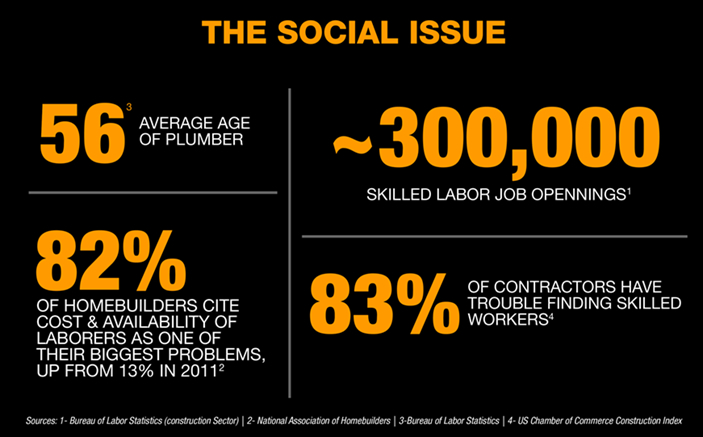
We recently talked with Erik Listou, Co-Founder of the Living In Place Institute, about trade professionals. He shared with us his insights and piqued our interest in his organization’s education, which provides practical tips for tradespersons, elevates respect for this vital pillar of the housing industry, and helps skilled trade professionals network within the rest of the industry. Adding our own research and working together, Erik and I seek to propel our industry… one home at a time.
During the past several years, there has been continuing concern about the scarcity of trade professionals. And how our industry can increase interest in careers within these professions. While many programs have been introduced to promote the home and building product channel as a viable — and rewarding — career path, these initiatives deserve further commitment.
Currently, millions of Americans who have lost their jobs due to the pandemic continue to search for employment. At the same time, the number of skilled labor jobs in the U.S. is significantly exceeding the supply of workers qualified to fill them. A recent analysis by PeopleReady’s skilled trades division found that the most in-demand opportunities remain unfilled for a month, on average.
And yet, the opportunity for rising wages is not limited… as it is, for restaurant and hospitality workers.
So, what’s the solution?
Perhaps what’s needed instead are programs that start by elevating the respect level of current trade professionals. Both within the industry and aimed at the public. With focused messaging campaigns that promise compelling incentives for those entering the profession.
Says Jill Quinn, executive leader of PeopleReady Skilled Trades, "The skilled trades are in dire need of workers right now, with a particularly high demand for apprentice-level and skilled labor positions. These are steady, well-paying jobs that hold a bright future, even in an unpredictable economic climate."
How did we allow this situation to evolve?
The Value of a Tradesperson
The value of building trade professionals has been surrounding us throughout history. From the pyramids of ancient Egypt to our own front doors — it takes a skilled worker to make everything fit together — and work properly. Most of us have learned from our own personal experience that craftspeople truly do bring designs to life.
Can you imagine starting with over 100,000 individual parts? Combining them into about 3,000 major components — and then putting them all together into what we call a "home" — all in just a few months? Building professionals in the U.S. have performed that seemingly miraculous task some 128 million times from the ground up. What’s more… when we add in more than $300B annually in remodeling and repairs, we can begin to grasp the scope of this opportunity.
Worldwide, there are more than one billion homes… and trade professionals were involved in virtually every skilled installation. In fact, trade professionals impact the daily lives of almost eight billion persons. That’s a lot of influence.
What Trade Professionals Earn
In a report published in July 2020 by the U.S. Bureau of Labor and Statistics, annual salaries for all types of U.S. workers average about $52K. College graduates earn $73K on average — while for those with only high school educations — that number to drops to around $41K. The average kitchen designer salary in the United States is $44,378, reports Salary.com. And according to ZipRecruiter, in 2020, the average annual pay for a trade professional in the United States was $44,464 a year.
"It’s important that people going into artisan work, for all the camaraderie and job fulfillment satisfaction, to know that it’s often fair-weather work, with little or no sick leave, often with no guarantees, benefits or pension," says Llewellyn King, a world-renowned journalist. Using the phrase Mr. King coined years ago, "Now it is time to break through the "Mortar Board Ceiling."

Education Costs
Midwest Technical Institute reports that, while the average cost for a four-year college degree is listed at $9,410 per year, most graduates end up paying around $127,000 for their degree. Of those, at least 20 percent graduate with more than $50,000 in debt. And nearly 6 percent graduate from a four-year university with more than $100,000 in student loan debt.
Compare that to the average cost of attending a trade school — which is $5K-$15K — and takes between three to 18 months to complete. As with any skilled profession… getting out in the field, and doing the work is what matters most. Many tradespersons learn their tasks literally in the "school of hard knocks." Perhaps that’s why the European apprenticeship model is so successful.
The Industry Responds
To address the growing skilled labor gap, The Home Depot launched in 2020 an ambitious education and job placement program called Path to Pro… as an expansion of The Home Depot Foundation’s $50 million trades training commitment. The program — which aims to educate people in the skilled trades — connects them with jobs and careers. And helps spur interest in trade professions through educational campaigns… certifying more than 3,600 people to date.
Additionally, The Home Depot and The Home Depot Foundation recently partnered with SkillsUSA, along with sponsors like Klein Tools, 84 Lumber and NC3 for National Signing Day 2021. Each of the sponsors awarded scholarships to SkillsUSA students in four major U.S. regions… providing opportunities for hundreds of high school seniors who plan to enter the skilled trades.
Organizations like Hope Renovations have introduced a similar approach to training, in this case targeted to underemployed women. The organization offers a 10-week pre-apprenticeship training program that teaches the fundamentals of carpentry, plumbing, electrical, painting, finishing and landscaping – providing trainees with the skills to confidently enter the trades. Or enroll in apprenticeships and continuing trades education.
Going In-depth
According to Erik Listou, co-founder of the Living In Place Institute, "the housing industry has always been naturally divided into three different groups, or Pillars of the Housing Industry."
These pillars include Trade Specialists, who are responsible for installing and bringing to life housing designs — Designers, Builders and Architects — who handle the overall design, management, and major elements. As well as Manufacturers, Suppliers, Engineers, Realtors… who develop and supply products and support services.
The Living In Place Institute was created to address the need for advanced professional education and credentials for each pillar. After completing advanced technical education classes that focus on industry-wide home safety and health… both seasoned industry veterans and new skilled trades workers are able to earn the Home & Accessibility Trade Specialist™ (HATS™) certification. Graduates have access to special live and virtual networking forums, continuing education, and are able to post their skills and contact information on the Living In Place Institute website. Which helps to match their talent with those looking to hire.
Larger Implications
Left unchecked, the shortage of skilled tradespeople isn’t only impacting hiring. It also has the potential to limit the growth of the building products sector. Unprecedented pandemic-spurred growth in construction and home renovations during the past year is expected to continue into 2022 and beyond. So, demand for skilled trades will continue to grow.
Fortunately, while the issue still looms large, the industry is making significant strides in addressing this important challenge.
As the president of The National Remodeling Foundation, I am proud of our organization’s success in providing scholarships and education to individuals who are entering the Remodeling Industry. To learn more, visit www.nationalremodelingfoundation.org
